This creamy hummus combines chickpeas, olive oil, garlic, tahini and cumin for a healthier, plant-based protein dip with a spicy kick. Enjoy it with vegetables and pita, or as a spread on crackers, sandwiches and wraps.
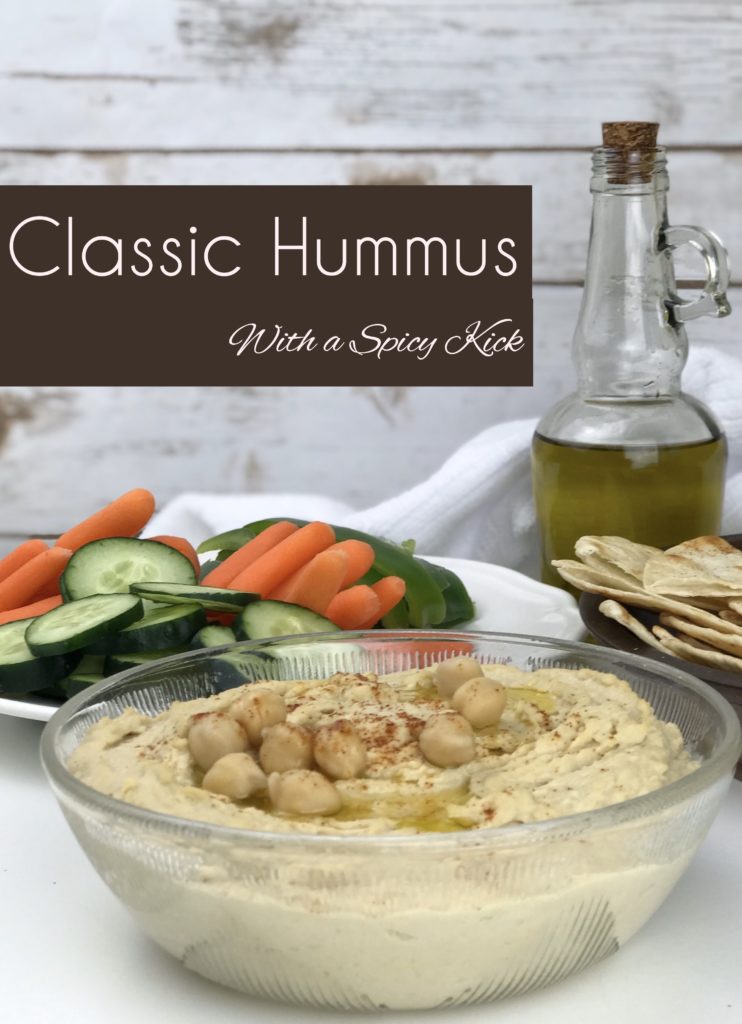
A couple weeks ago, I was in New York city for work and stopped to have dinner at the cutest Mediterranean restaurant. I opted for one of my favorite meals – the mezze plate. I love snack platters that offer a variety of foods and flavors, especially when someone else makes it for me! My plate consisted of hummus, eggplant matbucha, marinated olives, tzatziki and grilled flatbread. It was absolutely delicious! Since then, I’ve been on a major hummus kick.
I’ve made homemade hummus quite a bit, but I never took the time to write-out the steps or put it on my blog. I decided it was time, so Saturday, I did just that. It worked out well actually. My daughter had a friend coming over and we planned to have movie night. Rather than popcorn, I decided to make my own mezze platter for the family. We made the hummus, then put it on a platter with pita, vegetables, olives and dates. I also made a plate of cheese, crackers and grapes. It was the perfect combination of savory, sweet and spicy – something for everyone.
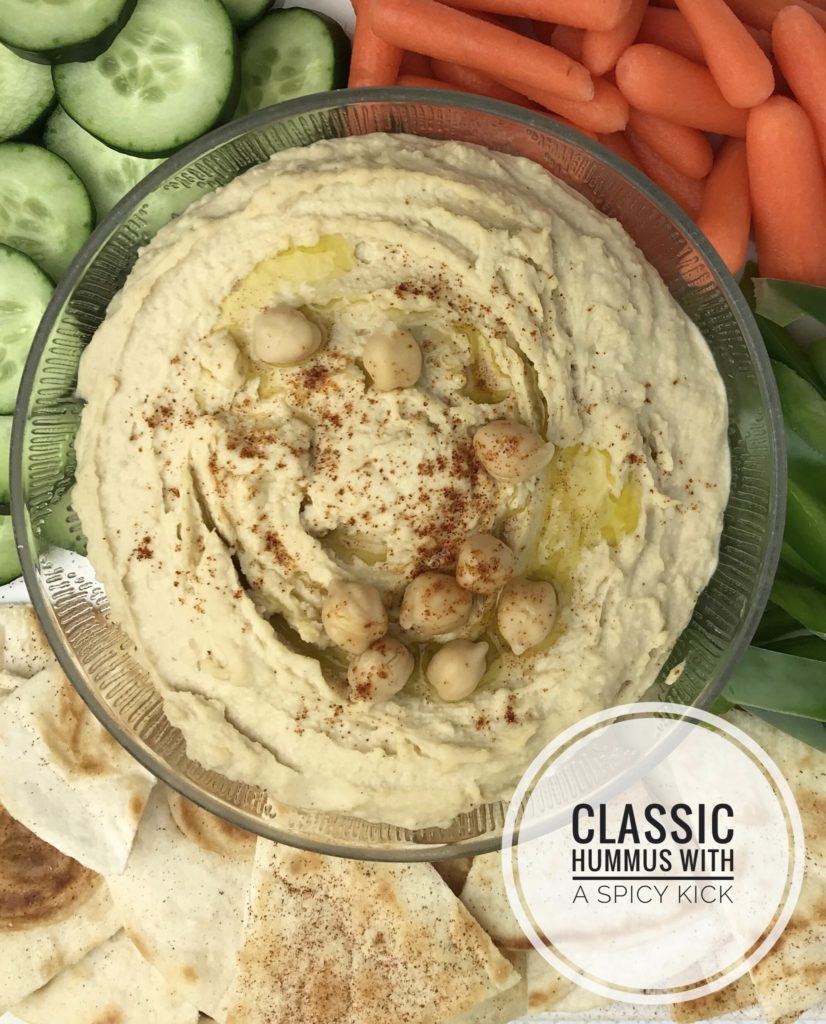
For those of you that have never had hummus, don’t know what it is, or wonder if it’s healthy, read on. I’m sharing some hummus history and nutrition facts with you. If you’re here just for the recipe, go ahead and scroll down to the section titled, “How to Make Hummus.” I walk you step-by-step through the process, or you can print the recipe card at the end of this post.
What Is Hummus?
Hummus is a popular spread in Mediterranean and Middle Eastern cuisines and has exploded in popularity in the states. Traditional recipes combine smashed chickpeas, sesame, lemon juice and garlic to make a spread. Back then, it was commonly added to stews, casseroles and other hot dishes. Today, hummus is widely consumed as a dip to accompany vegetables, flatbread bread, olives and other finger foods.
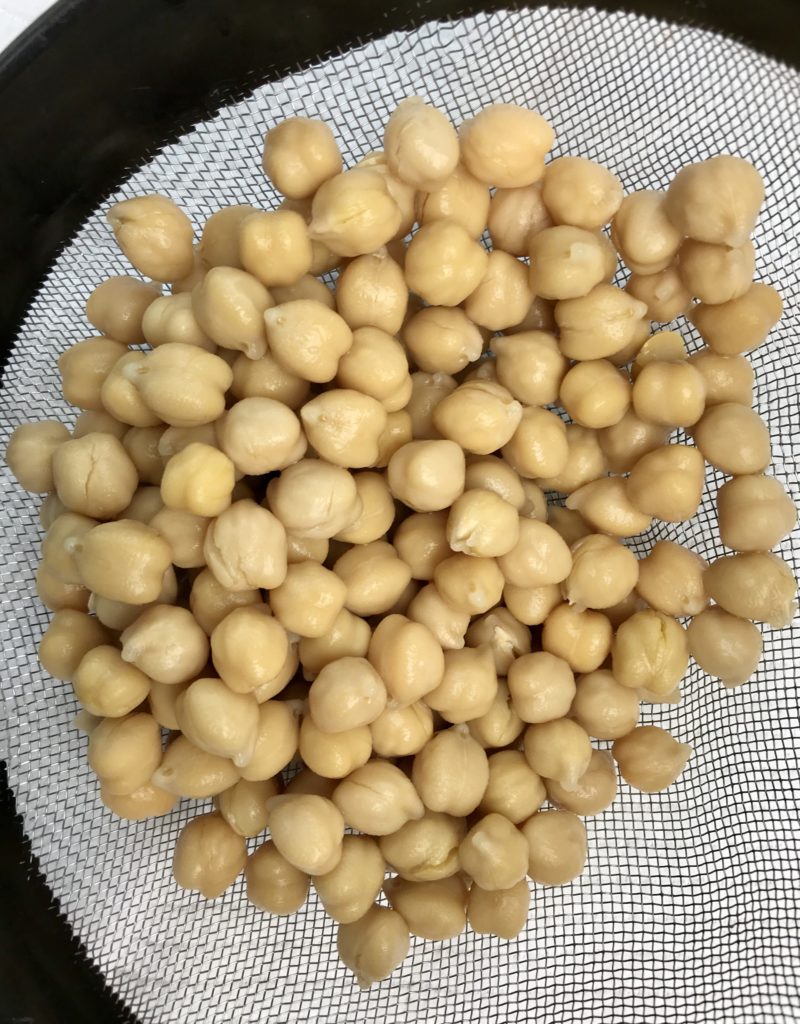
There are countless ways to make hummus, but the star ingredient in most versions is chickpeas. Classic recipes process the traditional ingredients listed above into a chunky or pureed consistency. Today, however, hummus recipes use a wide range of ingredients, herbs and spices to produce different flavors and textures. There’s even such a thing as dessert hummus. I can honestly say I’ve never tried a hummus flavor I didn’t like.
Is Hummus Healthy?
From my experience, most people view hummus as a healthy food. And, I agree. The combination of plant-based ingredients make it a heart-healthy option. The true healthfulness of the dish, though, depends on how it is made.
Chickpeas can be purchase either canned or dried. Both varieties provide a good source of plant-based protein, fiber, iron, phosphorus and other vitamins and minerals, but the exact nutritional profile will vary slightly based on which type you use. Using canned chickpeas reduces the prep time considerably, but they’re also higher in sodium than dried. The type you choose should be based on what you like, how much time you have, and your own health considerations.
Other ingredients in hummus add to the healthfulness, too. Lemon juice is rich in vitamin C – a powerful antioxidant that helps limit the damaging effect of free radicals and support immune function. High-quality virgin olive oil and tahini are packed with polyphenols and other plant compounds shown to be beneficial to human health. Both are recognized for their powerful antioxidant and anti-inflammatory properties. When you add all of these ingredients together, you end up with a nutrient-rich dip that’s filled with flavor.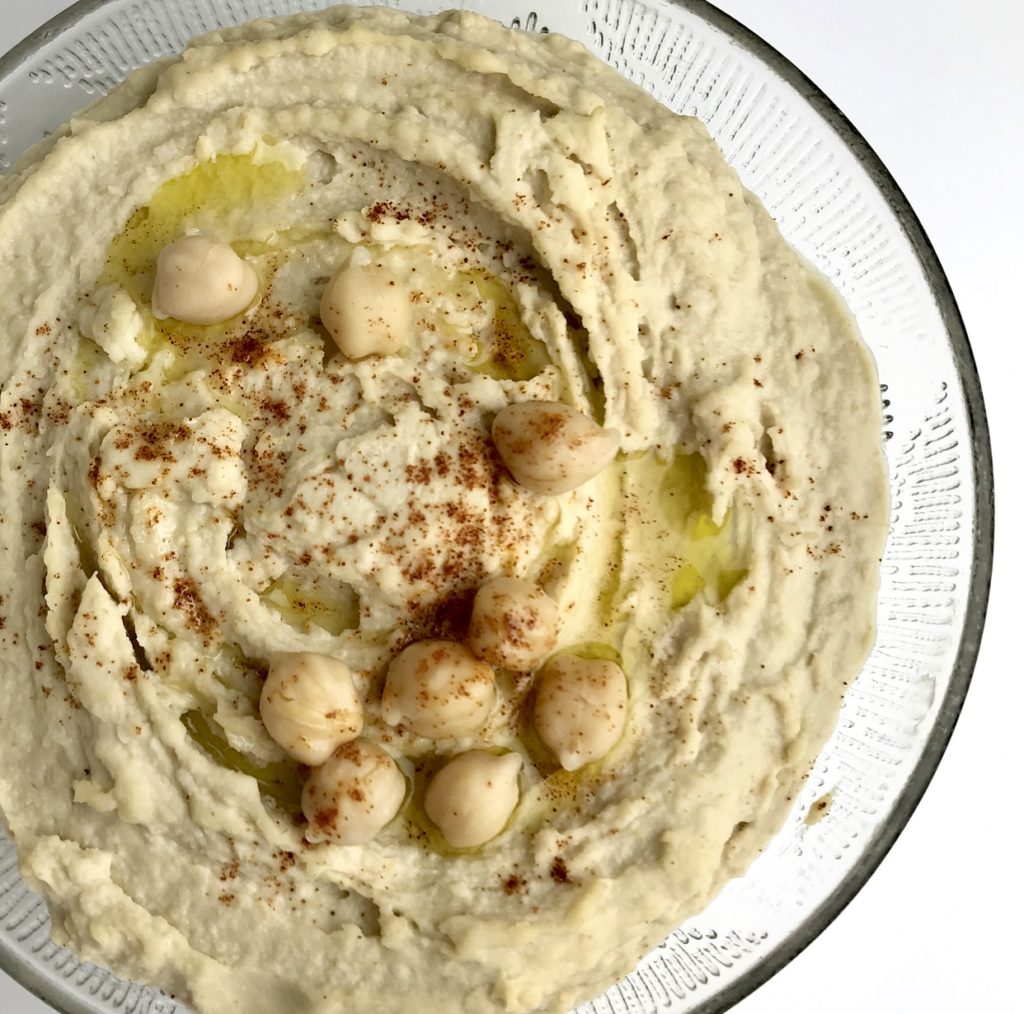
Calories and Macronutrients in Hummus
Hummus is often referred to as a protein-packed food, but, it doesn’t have as much as you may think. A ¼ cup serving provides ~5 grams, and while that’s good, you’d have to eat a lot of hummus to get close to your daily needs. You’ll want to incorporate a variety of foods, and other protein-rich foods, into your daily plan to reach the recommended protein requirement.
What hummus does have is a healthy combination of both fiber and healthy fats. The ¼ cup serving that I mentioned above contributes ~3 grams of fiber. To put that into perspective, the recommended daily intake for adults aged 18-50 years old is 38 and 25 grams for men and women, respectively. Over 50, that recommendation drops to 30 grams for men and 21 grams women.
As healthy as hummus is, it is not a low-calorie food. It’s still important to be mindful of how much you eat, and what you eat it with. Put a pre-portioned amount in a dish and eat it with nutrient-rich raw vegetables like carrots, broccoli, peppers and tomatoes.
How To Make Hummus?
Now the fun part – cooking! As I mentioned above, there are endless ways to make hummus, but this recipe is a classic variety, with a twist. I added cumin to give it a bit of a spicy flavor, and completely pureed the chickpeas to make a creamy consistency.
The best thing about hummus is how easy it is to make. I mean – super easy! My daughter and her friend actually made the hummus we ate Saturday night. I wrote the recipe, but they measured the ingredients, crushed the garlic and pureed it to a perfect consistency.
As with all recipe creations, the first time isn’t always a homerun. Our first batch turned out ok, but my daughter felt it tasted too much like tacos. {I guess I went a bit overboard on the cumin!} I took it down a notch for a second try and it was perfect.
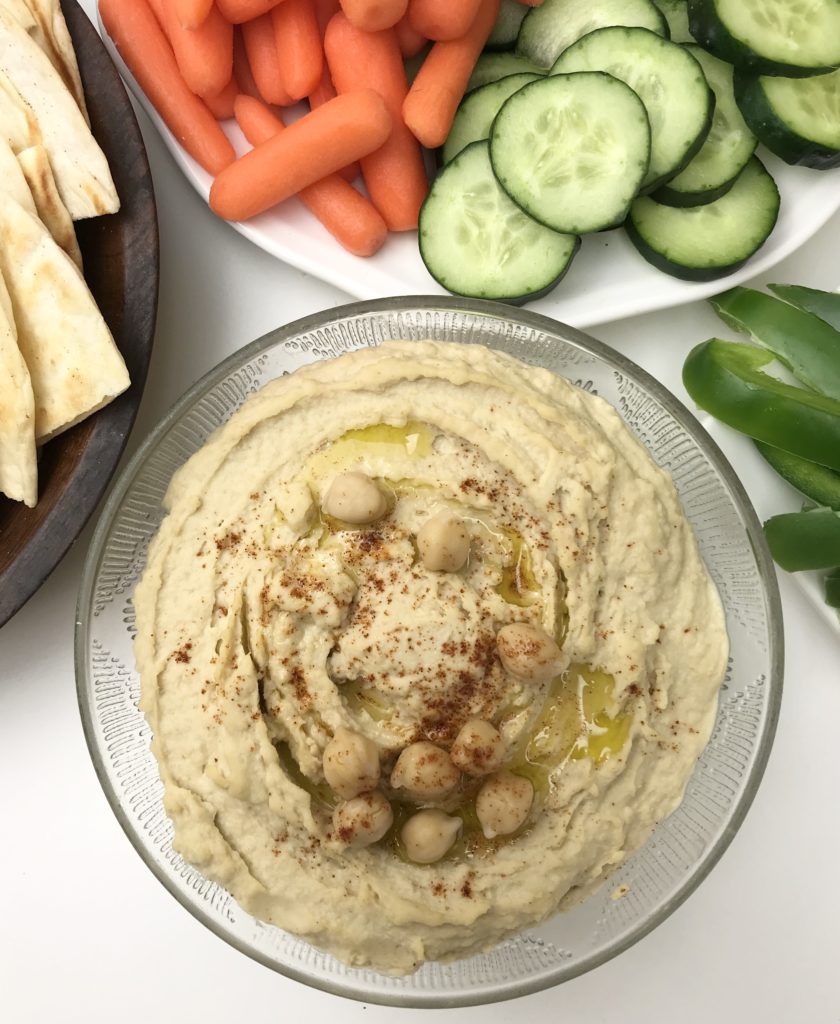
STEP #1:
The first step in making this hummus is to drain and rinse the canned chickpeas. Canned beans are much higher in salt than dried and rinsing can help reduce the total sodium content.
I like to measure all of my ingredients before I begin. You certainly don’t have to, but I find it helps to make sure nothing was left out. I’ve don’t that before, and it’s dreadful to have to start over when you discover it.
STEP #2:
Crush the garlic with a garlic press, then add to a medium bowl with the tahini, olive oil, cumin, salt, and lemon juice. The garlic will be processed in the food processor, so it’s ok if some pieces are larger than others. Stir well, then set aside.
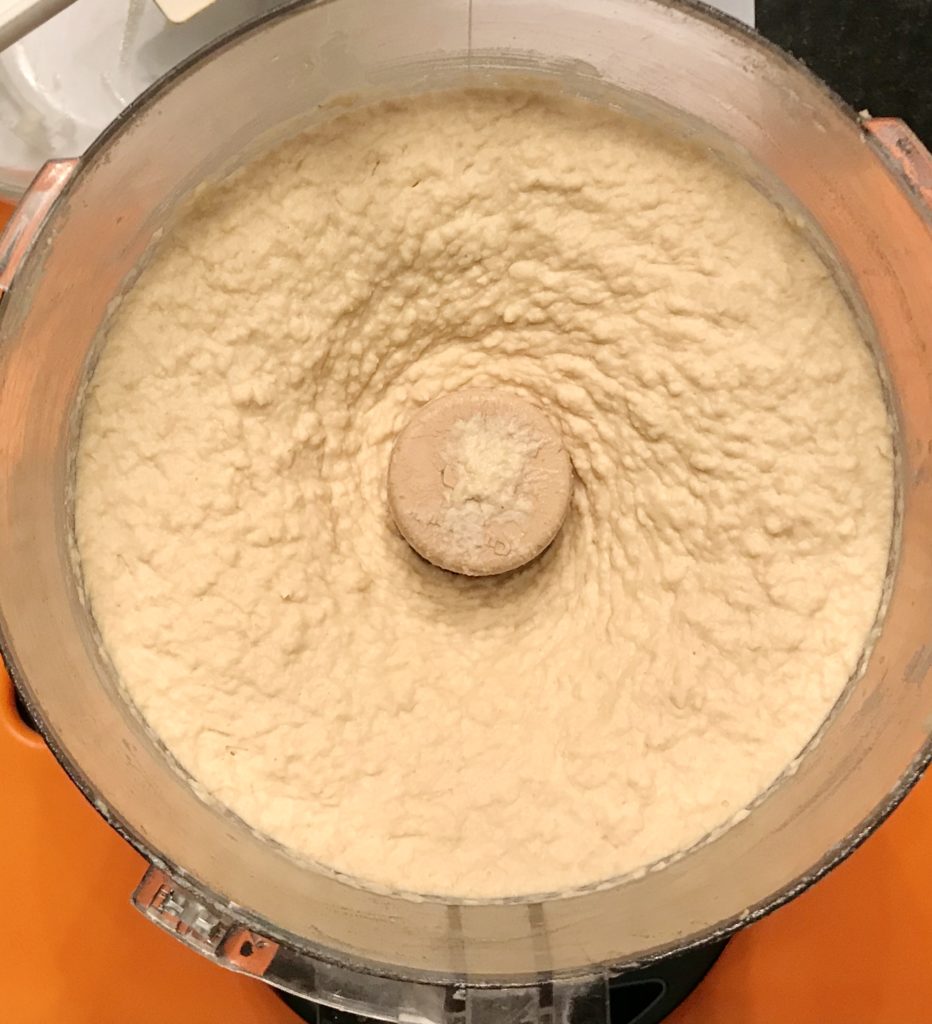
STEP #3:
Next, put the rinsed chickpeas and ¼ cup water in a food processor and process for ~10 seconds. Stop to scrape the sides, then continue processing another ~10 seconds. This is just the initial processing of the peas to loosen up the skin. The chickpeas will be dry and lumpy.
STEP #4:
Add the tahini mixture to the chick peas and process for ~30 seconds. Stop to scrape the sides, then continue to process for ~1-2 minutes. The hummus should be a super smooth consistency, but if it seems too thick, you can just add an additional tablespoon of water.
STEP #5:
Taste your hummus before you remove it from the food processor to check the flavor. If you like it spicy, you can add more cumin, and even a bit of paprika. You can also add more salt if you feel it needs it. Just note that the nutrition facts included below are based on the measurements I included in the recipe. Adding additional salt with change the total sodium content per serving.
Now you are ready to enjoy your hummus, or you can transfer it to an air-tight container and store it in the refrigerator. Homemade hummus should stay fresh between 3-5 days if stored properly.

This recipe can be ready in 10 minutes. Hummus is great paired with fresh pita, pita chips and vegetables. It can also be used as a spread for sandwiches and wraps, in place of mayonnaise for deviled eggs, or as an ingredient in salad dressings. There are so many ways to eat hummus. Do you have a favorite way? Share in the comments below.
Classic Hummus with a Spicy Kick
Ingredients
- 2 cans chickpeas, rinsed and drained
- 1/4 cup cold water
- 1/4 cup olive oil
- 1/4 cup fresh lemon juice
- 1/2 cup tahini
- 3/4 tsp cumin, ground
- 4 garlic cloves, peeked and smashed
- 3/4 tsp salt
Instructions
- Crush the garlic with a garlic press, then add to a medium bowl with the tahini, olive oil, cumin, salt, and lemon juice. Stir well and set aside
- Put chickpeas and ¼ cup water in a food processor and process for ~10 seconds. Stop to scrape the sides, then continue processing another ~10 seconds. Chickpeas will be dry and lumpy.
- Add the tahini mixture to the chickpeas and process for ~30 seconds. Stop to scrape the sides, then continue to process for ~1-2 minutes. The hummus should be a super smooth consistency. If it seems too thick, add an additional tablespoon of water.
- Taste and season with additional cumin, as desired
- Enjoy immediately or transfer to an air-tight container and refrigerate
Notes
- NOTE: Stays fresh for 3-4 days
- Makes: 3 1/4 cups of hummus
- Serving Size: ¼ cup
- Servings per recipe: 13
- Nutrition Facts: 150 calories, 12 g carbohydrates, 3 g fiber, 2 grams sugar, 10 g fat, 1.5 g saturated fat, 0 mg cholesterol, 5 grams protein, 210 mg sodium, 2% DV potassium, 6% DV iron, 2% DV calcium.
DID YOU MAKE THIS RECIPE? Tag @heathermangieri on Instagram and hashtag it #HeatherMangieriNutrition to all recipes. Or, Pin it on Pinterest for later!

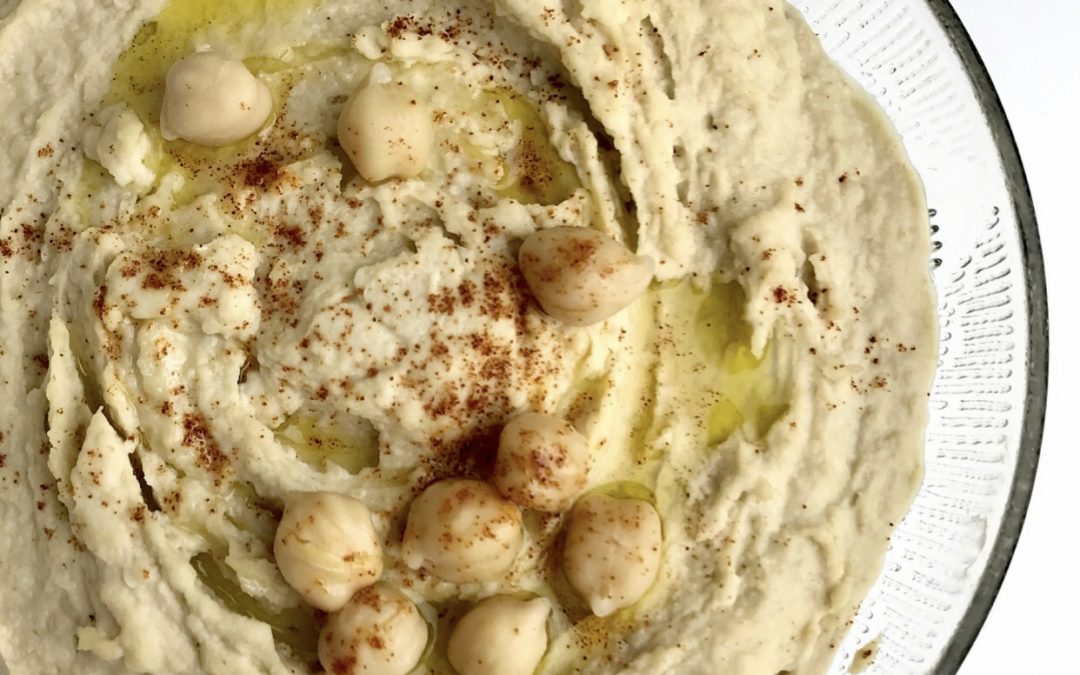
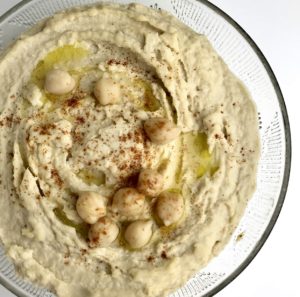
 Hi, I’m Heather – a registered dietitian, busy mom, consultant, adventure junkie and travel addict who has mastered living healthy on the go. My blog is where I share simple recipes and healthy living tips to help and inspire others to live their best life.
Hi, I’m Heather – a registered dietitian, busy mom, consultant, adventure junkie and travel addict who has mastered living healthy on the go. My blog is where I share simple recipes and healthy living tips to help and inspire others to live their best life.
Oh I can’t wait to make this!
You forgot to mention that hummus is Arabic word for chickpeas and so is the origin of the dish.thank you
Very healthy meal
People’s in palstine the. Do it from 6000 years
Yes hummus does not mean dip it is the arabic word for chickpeas as it is the main ingredient.
It is worth mentioning that olive oil should not be added while mixing but on top of the dish when it is ready to eat and not on the whole batch
Also if you substitute cumin by cayene pepper you will find it tasty that is if you like your food hot. You can also add both